How will Vaccines Impact the 2021 U.S. Economy?
How will Vaccines Impact the 2021 U.S. Economy?
This is a recap of the March 4 webinar, Market Pulse: Return to Opportunity for Commercial Real Estate. We’re sharing key insights on the future 2021 economy offered from Robert Wescott, Founder and President at Keybridge.
Early 2021 Economic Path
A year after COVID-19 began, economists are taking stock and predicting what the future economy may look like. Robert Wescott identified three key areas that he believes will dictate economic growth, including manufacturing, consumer spending and the labor market.
Manufacturing is currently in a good place and leading the world economy, according to Wescott. The chart below shows the Purchasing Managers’ Indexes (PMI) for manufacturing. In Europe, the U.S., China and Japan manufacturing is in expansion mode. This is good news for the economy as it means increased job creation and economic growth. In contrast, the right side of the chart shows that services are still lagging and in contraction mode in Europe and Japan. The U.S. is doing better in the services industry. Wescott credits this to the $4 trillion in stimulus spending and that U.S. services are more amenable to remote work.
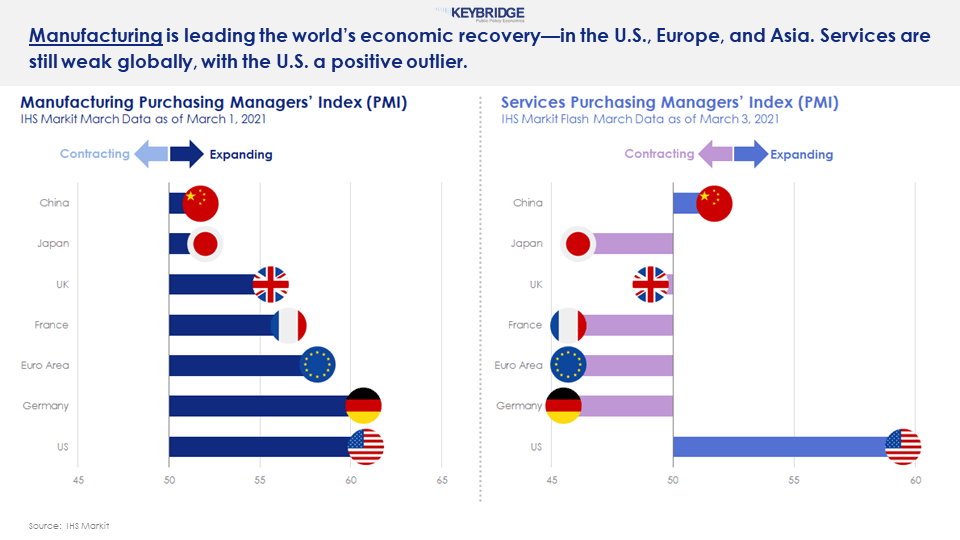
Consumer Spending
Looking at consumer spending, Wescott cited that spending has mainly been moving sideways, and this hasn’t been helped by surging COVID-19 cases seen in January and February 2021. OpenTable U.S. Seated Diners, which reports on numbers of diners at restaurants is 39% below normal, gasoline demand is down 5 - 20%, and mobility measures are down 50 - 60%, pointing to a decreased willingness for consumers to leave home or travel.
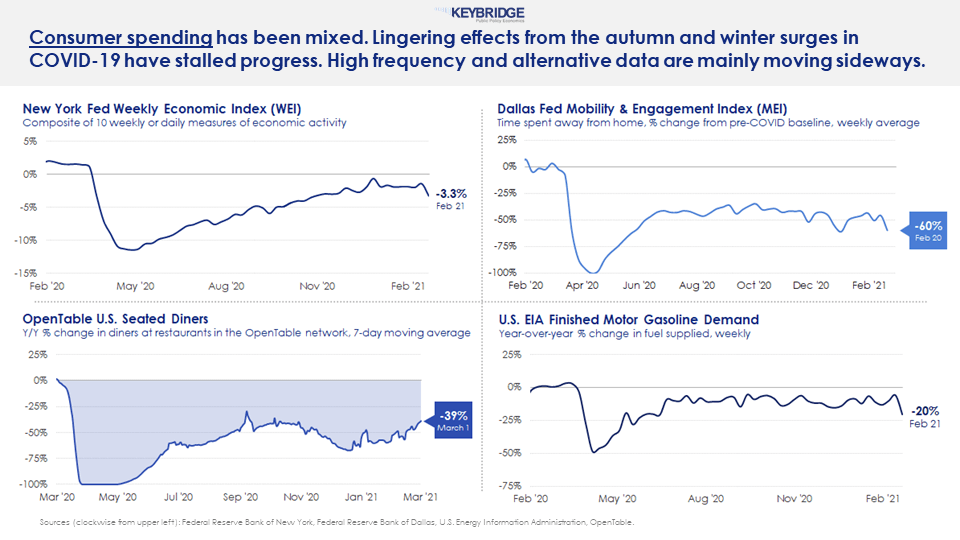
Labor Markets
Finally, the labor markets, which had 20 million jobs lost in April 2020, point to a challenging road to recovery. Wescott explained that there has been some positive movement; however, there is a long way to go before we reach pre-COVID numbers. February unemployment numbers from the Bureau of Labor Statistics reported that nonfarm payroll employment rose by 379,000. However, the unemployment rate didn’t show drastic change and was reported at 6.2% with 10 million unemployed persons, compared to February 2020 numbers at 3.5% unemployment rate and 5.7 million unemployed persons.
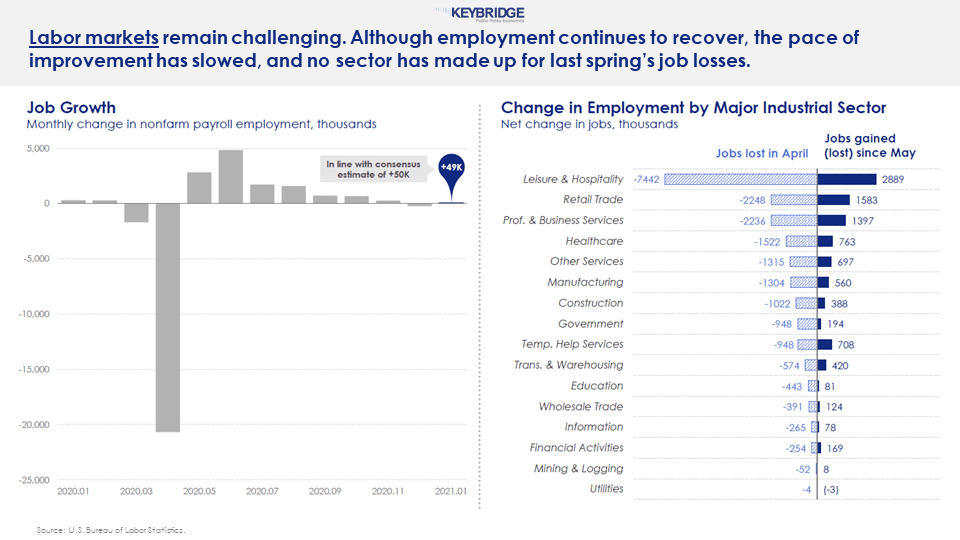
Wescott further explained that while jobs are coming back, no sector of the U.S. economy is whole compared to the jobs lost in April 2020. As can be seen in the chart above, the pace of improvement has slowed. Prime examples include transportation and warehousing, which added 420,000 jobs since May 2020, but lost 574,000 in April 2020 alone.
How will Vaccines Impact 2021 Growth?
When considering the direction the economy will move in 2021, it’s important to account for the COVID vaccine distribution. Initial data around vaccines is encouraging and shows that it is working well. In the U.S., overall cases from mid-December through mid-February were only 58% of what they were in December. In comparison, for prioritized populations like residents of nursing homes, cases were only 19% of their December levels. Deaths are also down sharply. Additionally, in Israel where about half of the population has been vaccinated, hospitalizations are down by two-thirds. Furthermore, an analysis of people vaccinated versus those who have not has shown a 94% vaccine effectiveness. An even more encouraging result in Israel showed a 90% reduction in the transmissibility for those who were vaccinated.
With vaccines becoming more widely available and more people getting vaccinated, the much anticipated discussion of herd immunity has come to the forefront. The graph below shows possible timelines for when herd immunity may be reached in the U.S. based on a mix of assumptions and currently available data. It factors in that 10% of the population has already had COVID-19 and recovered. Rising from the bottom left starting in January 2021, the dark blue line shows those who have already been vaccinated, which is currently at 16% of the U.S. population. But what number does the U.S. need to reach for herd immunity? According to Dr. Anthony Fauci, it is between 70 - 90%.
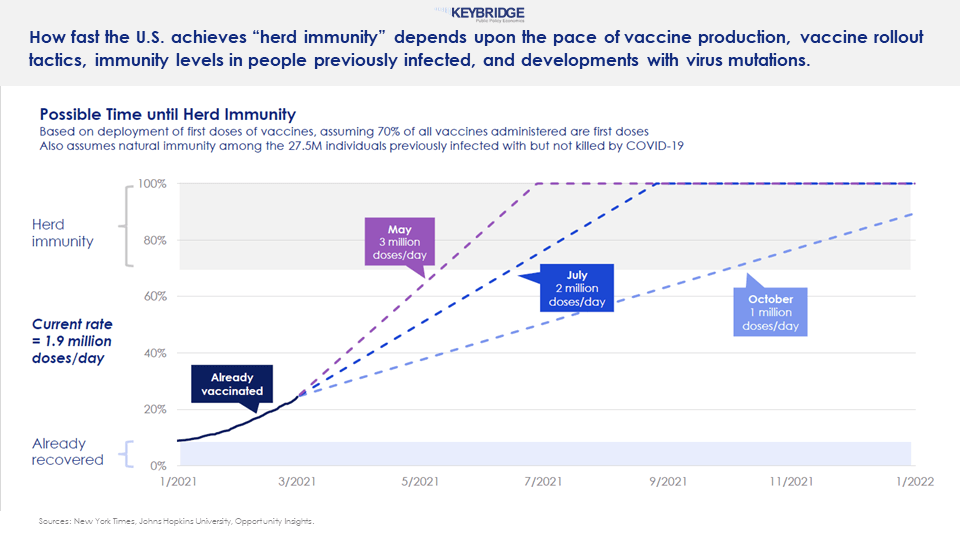
What is the Best Possible Outcome?
The best possible outcome is if the U.S. can vaccinate 3 million people per day, then herd immunity could be reached by May. With 2 million vaccinations per day, herd immunity could be reached in July; and 1 million doses per day would put us at herd immunity in October. Wescott explained the baseline case is assumed to be 70% immunity by July or August, though new virus variants or other factors could affect this prediction for the worse. If realized the baseline case would lead to more offices reopening in the second half of summer, people booking travel, and more businesses coming back. Additionally, Wescott hypothesized that in-person conferences would resume in October or November. All things considered, this could be consistent with a 4 - 5% Gross Domestic Product (GDP) growth in 2021. Or if immunity is reached earlier in May or June, we could be looking at a 6% GDP growth.
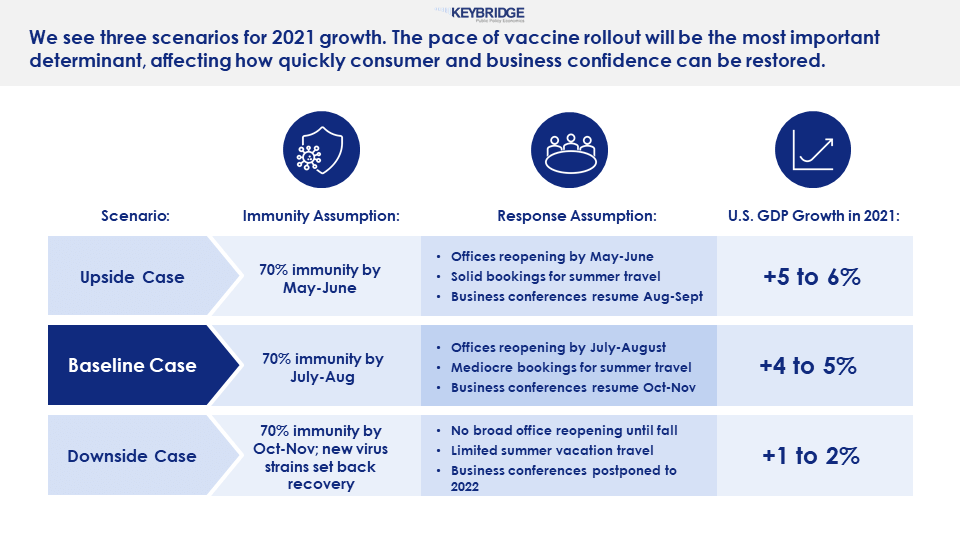
Business Sector Growth Changes
Businesses have also been hard hit by the economic slowdown. However, some sectors have been more resilient in weathering the storm. As pictured in the chart below, the top left shows sectors that have not only survived, but flourished during COVID-19. They include telecommunications, residential construction, manufacturing, food/beverage retail stores, and business and professional services. They are contrasted by the bottom left sectors that have struggled with slowdowns and even shutdowns due to the pandemic. These include restaurants and bars, airlines and hotels, event planning, movie theaters and all high-human touch personal services industries. Longer-term COVID-19 resilient industries include utilities, residential construction, broadband wireless/streaming services, defense and e-Commerce. Wescott warned that sectors like small businesses, shopping malls, commercial real estate/offices, higher education, business and international travel face long-term challenges.

Could We Overstimulate the Economy?
The U.S. economy entered into a deep recession in 2021, but it’s important to note that impacts have been experienced disproportionately by the population, as can be seen by the K-shaped recovery. The top half of the K is made of people who are handling the economic impacts of COVID-19 just fine and earn $100k or more in income, between 55 and 75% of whom can work from home. These individuals are more likely to have kept their jobs and health benefits -- and benefited from stock market gains. The bottom half of the K is made up of people who have not fared as well. They are experiencing pandemic-driven losses and financial uncertainty. Of this group:
- Only 10 - 25% can work from home
- Many work in low-wage industries that have suffered high unemployment rates
- The bottom 50% of households own only about 1% of U.S. equities, so they would not have benefited from the booming stock market like the upper K
Stimulus Targets Lower Half of K
The latest stimulus plan of the $1.9 trillion American Rescue Plan is targeted to the lower half of the K. [Note: This plan was recently passed by Congress, and the relief bill is expected to be signed by President Biden on March 12, 2021.] However, it has sparked debate amongst economists according to Wescott. He said some fear the amount is too large and could lead to inflation. The counter to the inflation argument is that there has been strong inflation anchoring, which would limit inflation. And if inflation does start to uptick there are tools in place to fight it. With so much on the horizon, it will be critical to watch the economic and health landscapes.

The full webinar recording can be accessed by visiting Market Pulse: Return to Opportunity for Commercial Real Estate and you can download a copy of the presentation slides here. And, if you would like to speak to an Equifax representative about any of the data or solutions mentioned in this blog, please contact us today.
Recommended for you


